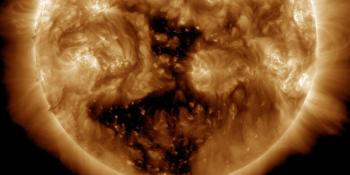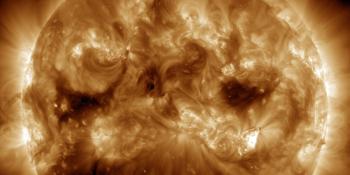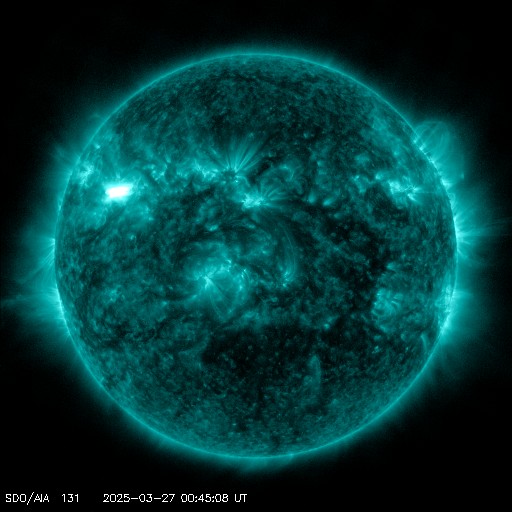Viewing archive of Thursday, 19 July 2012
Solar activity report
Any mentioned solar flare in this report has a scaling factor applied by the Space Weather Prediction Center (SWPC). Because of the SWPC scaling factor, solar flares are reported as 42% smaller than for the science quality data. The scaling factor has been removed from our archived solar flare data to reflect the true physical units.
Report of Solar-Geophysical Activity 2012 Jul 19 2200 UTCPrepared by the NOAA © SWPC and processed by SpaceWeatherLive.com
Joint USAF/NOAA Report of Solar and Geophysical Activity
SDF Number 201 Issued at 2200Z on 19 Jul 2012IA. Analysis of Solar Active Regions and Activity from 18-2100Z to 19-2100Z
Solar activity was high. Shortly after rotating off
the west limb, Region 1520 (S17W90) produced a long duration M7
event with max at 19/0558Z. The event was associated with a Type II
sweep (1110 km/s), a Tenflare (1000 sfu), and a Type IV sweep. A
partial-halo CME was subsequently observed in SOHO/LASCO C3
coronagraph imagery beginning at 19/0606Z with an estimated
plane-of-sky speed of about 1500 km/s. This CME is not expected to
be geoeffective. Region 1523 (S28W64) and Region 1524 (S16W24)
showed slight decay. Region 1525 (S22W23) increased over the course
of the period and produced a C-flare.
IB. Solar Activity Forecast
Solar activity is expected to be low
throughout the period.
IIA. Geophysical Activity Summary 18-2100Z to 19-2100Z
Geomagnetic field activity was generally quiet. The greater than 10
MeV proton event that began at 17/1715Z continued with an
enhancement from the 19/0513 M7 event, reaching a max value of 79
PFU at 19/1425Z during the analysis interval. The greater than 2 MeV
electron flux at geosynchronous orbit was at high levels throughout
the period.
IIB. Geophysical Activity Forecast
Geomagnetic activity is
expected to be at quiet levels for the first and second days (20-21
July). An increase to unsettled levels with a chance for active
periods is expected on the third day (22 July) due to a favorably
positioned coronal hole. The greater than 10 MeV proton event that
began 17/1715 is expected to end on 20 July.
III. Event Probabilities 20 Jul to 22 Jul
| Class M | 10% | 01% | 01% |
| Class X | 01% | 01% | 01% |
| Proton | 90% | 20% | 01% |
| PCAF | red | ||
IV. Penticton 10.7 cm Flux
Observed 19 Jul 100 Predicted 20 Jul-22 Jul 095/095/100 90 Day Mean 19 Jul 128
V. Geomagnetic A Indices
Observed Afr/Ap 18 Jul 005/004 Estimated Afr/Ap 19 Jul 005/006 Predicted Afr/Ap 20 Jul-22 Jul 006/005-006/005-011/012
VI. Geomagnetic Activity Probabilities 20 Jul to 22 Jul
| A. Middle Latitudes | |||
|---|---|---|---|
| Active | 05% | 05% | 30% |
| Minor storm | 01% | 01% | 05% |
| Major-severe storm | 01% | 01% | 01% |
| B. High Latitudes | |||
|---|---|---|---|
| Active | 15% | 15% | 15% |
| Minor storm | 10% | 10% | 30% |
| Major-severe storm | 05% | 05% | 35% |
All times in UTC
Latest news
Latest forum messages
Incoming & Unnumbered Active Regions 1644AR4043 17Large Coronal Hole 25 152Photographing auroras 36Aurora photography hints for those of us with smartphones 43
More topicsSupport SpaceWeatherLive.com!
A lot of people come to SpaceWeatherLive to follow the Sun's activity or if there is aurora to be seen, but with more traffic comes higher server costs. Consider a donation if you enjoy SpaceWeatherLive so we can keep the website online!

Latest alerts
09:15 UTC - Geomagnetic activity
Minor G1 geomagnetic storm (Kp5) Threshold Reached: 08:59 UTC
06:27 UTC - Hemispheric Power Index
The OVATION model predicts the Hemispheric Power Index to reach 54GW at 07:01 UTC
06:00 UTC - Geomagnetic activity
Minor G1 geomagnetic storm (Kp5) Threshold Reached: 05:51 UTC
00:57 UTC - Solar flare
Moderate M2.05 flare
00:33 UTC - Radio Blackout
Minor R1 radio blackout in progress (≥M1 - current: M1.71)
Space weather facts
| Last X-flare | 2025/02/23 | X2.0 |
| Last M-flare | 2025/03/27 | M2.0 |
| Last geomagnetic storm | 2025/03/26 | Kp6+ (G2) |
| Spotless days | |
|---|---|
| Last spotless day | 2022/06/08 |
| Monthly mean Sunspot Number | |
|---|---|
| February 2025 | 154.6 +17.6 |
| March 2025 | 132.3 -22.3 |
| Last 30 days | 131.2 -21.8 |




